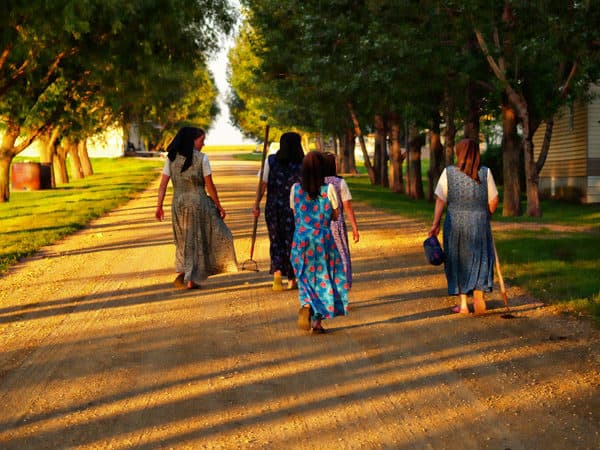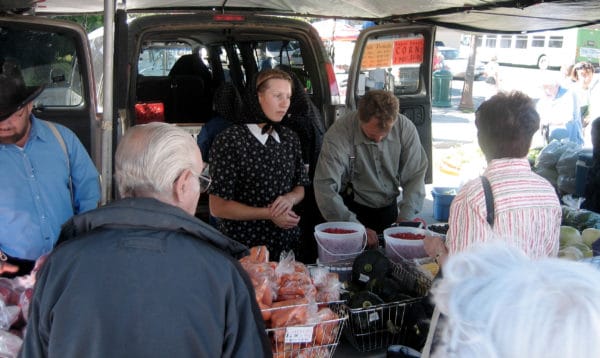Life Without Racial Conflict
Walter Osterman, American Renaissance, November 24, 2017
I was raised in a normal household, by two caring parents. I attended public schools and had normal friends. Every detail about my family appeared ordinary from the outside — but only from the outside. My parents were born and raised on a Hutterite colony, and every summer until I was a young adult I lived with the Hutterites.
Hutterites are a white Anabaptist group that originated in Austria in the 16th century. Over time, they migrated across Europe to escape persecution because of their belief in absolute pacifism. In the mid-to-late 1800s, they fled to North American to avoid Russian military service laws. Since settling in North America, they have built over 480 colonies with a population of over 40,000 members. Colonies are constantly expanding. They are examples of the peaceful, idyllic life that all-white communities can create for themselves.
From birth, Hutterites speak an old dialect of German, and use English only with “outsiders.” The majority of colonies in the United States are in Montana and the Dakotas. In Canada they are in Alberta, Saskatchewan, and Manitoba. The average family has four or five children. When colonies exceed 14-16 families, they buy land and establish a daughter colony. It’s typical for colonies to network, share burdens, and participate in gatherings; couples usually form in gatherings of this kind. After marriage, the woman generally moves to the colony where the man lives. The colony will have a house built for the newlyweds, or they may move into an existing house left by older members who have passed on. All colonies are rural, and members have family trees centuries long that trace back to Europe.
Old European culture and conservatism are very important to the Hutterites. A single leader for each colony is chosen democratically, and he manages everyday operations and usually sets ground rules. These rules may differ from colony to colony, and may cover whether outside family members can visit during religious holidays or how colony assets, property, and resources are used.
Hutterites stand out because of their clothes. Women wear colorful, ankle-length dresses and elbow-length shirts with a head covering called a tiechl. Men dress in plaid shirts and black pants. The dress code shows unity and dates back to the Austrian origins. Hutterites have no dietary restrictions. Smoking is not allowed, but there is some drinking — mostly of homemade wine. Hutterites go to church everyday. Other than the two church services on Sunday, the Sabbath is not a day of rest; Hutterites have too much work to do.

“Hutterite Sunset.” Photograph by Rainer Mueller. CC BY 3.0.
I was very young the first time I visited a colony in southern Alberta to meet my mother’s side of the family. At the time, I didn’t think the colony was strange. I just assumed it was a normal farm, but where people dressed a bit strangely. It wasn’t until kindergarten that I realized my family was different from others. The teacher sat down with each student and asked silly questions such as, “What is your favorite food?” To her surprise, my teacher had never heard of my favorite food — gashtel soup, or chicken broth with tiny dumplings — because it was exclusive to Hutterites. Since that time I always felt a bit different from my non-Hutterite classmates. Also, I never got visits from grandparents for my birthday or over Christmas because Hutterites so rarely leave their colonies.
When I was a child, I dreaded those summer visits. At home, I was used to all sorts of electronic entertainment, but at the colony the most sophisticated device was an AM/FM radio. The first couple of weeks therefore seemed incredibly bland. Nights were humid, and ducks made a racket until you passed out. Eventually, I melded into the experience and made the most of it. Looking back, it was great: wandering the gravel roads to catch the largest grasshopper, or the occasional frog; watching ants eat a dead baby bird that had fallen from the nest; shelling peas and doing bead-work.
But even in the colony, there were glimpses of the outside world, through newspapers and magazines. My grandparents subscribed to two magazines covering Canadian current events, and to National Geographic. Flipping through the pages really did feel like peeking into another world. I couldn’t imagine what my grandparents thought; they had never even seen mountains, much less Middle-Eastern war-zones or racial conflict. But they were not simple farmers. They kept up with current events and understand what went on beyond their homes.
The Japanese have a popular saying, “The nail that sticks out gets hammered down.” This outlook couldn’t be more true within a colony. Hutterites have a deep appreciation of their homogeneity. You have to be born into a colony because they never accept converts. Excommunication is extremely rare; shunning is how they hammer down any “protruding nails.” Ignoring someone or telling him to sit alone in church are usually all it takes to restore harmony.
One of the most important and controversial aspects of colony life is patriarchy. Men make most of the decisions, work in the shops, tend to the animals, and run the majority of colony businesses. Still, women have important roles: working in the garden, cooking, sewing, and taking care of children. In the past, colony members didn’t receive an education beyond the ninth grade, but that is changing. Members now attend community colleges and universities to become electricians, mechanics and even nurses. They then take these skills back to the colony. In emergencies — fires or flooding — Hutterites help neighboring farmers and communities.
For most of human history, luxuries like refrigerators didn’t exist. If meat was to last more than a week, it had to be smoked or cured with salt. Colonies still use these methods. In their daily meals, colonies use everything from root vegetables such as beets and potatoes to wild berries and dark cherries. They ferment food for winter consumption, and sell quotas to producers and surpluses at local farmers markets.

Hutterites at a farmers market. (Photo by Peter Merholz, Flickr, CC BY-SA 2.0)
Unlike the Amish (a cousin group), Hutterites use modern equipment to farm such crops as wheat, barley, oats, and canola. They never hire help from outside the colony, so everyone works, especially at harvest time. Sometimes nearby colonies pitch in to help with the harvest. Colony-managed livestock such as cows, pigs, chickens, sheep, and ducks are raised for member consumption, with surpluses sold to the public. Members do not waste animal byproducts. They use hides to make such things as winter gloves, feathers to make pillows and quilts, and animal fat to make soap. Hutterites are fiercely independent and take no government handouts.
As I get older, I remember things that were meaningless to me as a child. For example, the first thing anyone will notice walking into a colony is how clean and organized everything is. Grass, trees, roads and pathways are always maintained. Houses are immaculate inside and out, both in craftsmanship and cleanliness. Communal kitchens are fitted with stainless steel and tile, and there are industrial washing machines in the wash-house.
Hutterites live simply, dedicated to Christian pacifism and to their distinctive way of life. They don’t look down on anyone. In my experience, they never think or talk about race — they don’t have to. They simply want to be left alone, to let their culture thrive. Children grow up without violence, and elders are taken care of in return for the hard work they have put forth. Their lives are without forced racial or cultural integration — without conflict. What they have is a true community, a utopia of white homogeneity.















